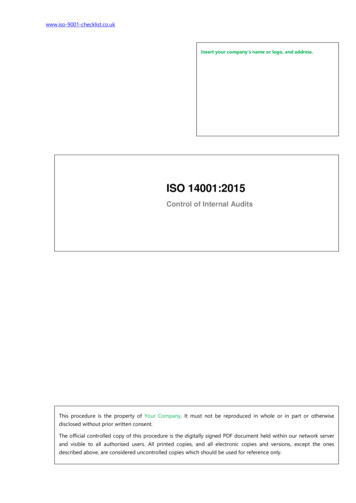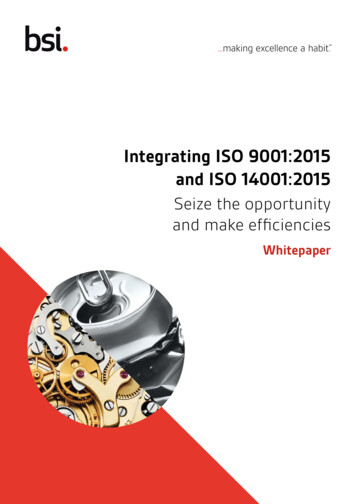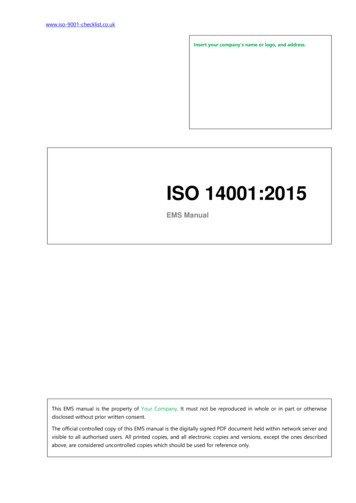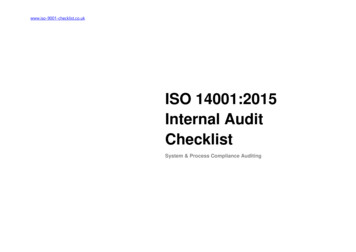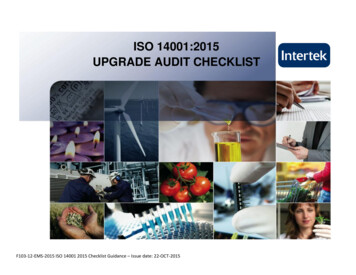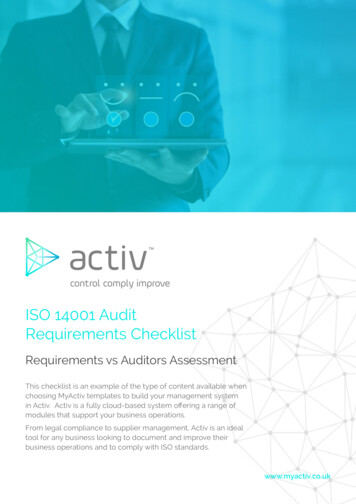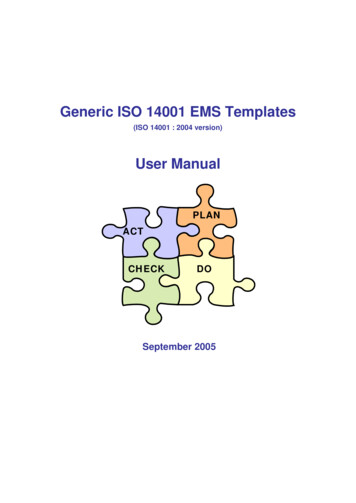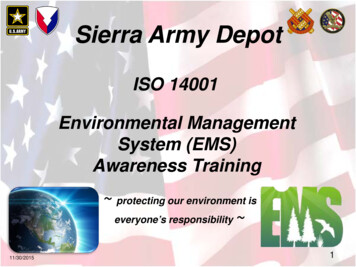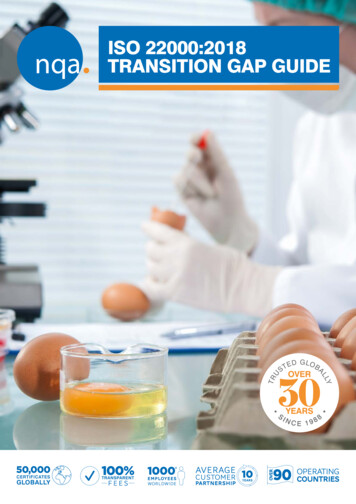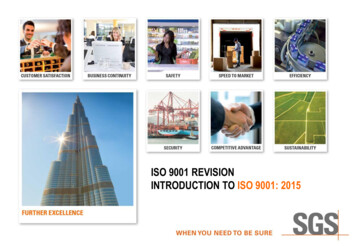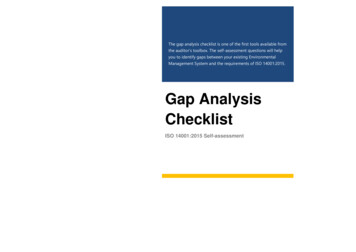
Transcription
The gap analysis checklist is one of the first tools available fromthe auditor’s toolbox. The self-assessment questions will helpyou to identify gaps between your existing EnvironmentalManagement System and the requirements of ISO 14001:2015.Gap AnalysisChecklistISO 14001:2015 Self-assessment
www.iso-9001-checklist.co.uk 2017Gap Analysis ChecklistISO 14001:2015 Self-assessmentTable of ContentsGUIDANCE . 2ABOUT THIS CHECKLIST . 2SUMMARY OF KEY CHANGES . 2Context of the Organization . 2Leadership . 2Risks and Opportunities . 3Strategic Environmental Management . 3Life-cycle Perspective . 3Performance Evaluation . 3HOW TO MAKE THE CHANGES . 3MINIMUM ISO 14001:2015 DOCUMENTATION . 4SELF-ASSESSMENT CHECKLIST . 6CONTEXT OF THE ORGANISATION . 6LEADERSHIP . 8PLANNING . 10SUPPORT . 13OPERATION . 16PERFORMANCE EVALUATION . 18IMPROVEMENT . 19Document Ref:Page 1 of 19
www.iso-9001-checklist.co.uk 2017Gap Analysis ChecklistISO 14001:2015 Self-assessmentGuidanceAbout this ChecklistThis gap analysis checklist highlights the new requirements contained in ISO 14001:2015, and is not intended to cover all of the requirementsfrom ISO 14001:2015 comprehensively. The unique knowledge obtained about the status your existing Environmental Management System (EMS) will be akey driver of the subsequent implementation approach. Armed with this knowledge, it allows you to establish accurate budgets, timelines and expectationswhich are proportional to the state of your current management system when directly compared to the requirements of the standards.Your organization may already have in place an ISO 14001:2004 compliant EMS or you might be running an uncertified system. If this is the case, you will wantto determine how closely your system conforms to the requirements ISO 14001:2015. The results of a gap analysis exercise will help to determine thedifferences, or gaps, between your existing management system and the new requirements. Not only will this analysis template help you to identify the gaps,it will also allow you to recommend how those gaps should be filled.The gap analysis output provides a valuable baseline for the implementation process as a whole and for measuring progress. Try to understand each businessprocess in the context of each of the requirements by comparing different activities and processes with what the standard requires. At the end of this activityyou will have a list of activities and processes that comply and ones that do not comply. The latter list now becomes the target of your implementation plan.Summary of Key ChangesContext of the OrganizationYour organization is now required to identify and asses all internal and external issues that could impact upon your EMS’s ability to deliver its intended results.You will need to develop a methodology to understand the needs and expectations of all interested parties. Examples of internal issues could include yourorganisation’s culture and capabilities, whilst external issues could include the effects of climate change, flooding and the availability of natural resources toname but a few. Your organisation should identify the stakeholders of its EMS and any requirements they have as this will influence the type and complexity ofmanagement system needed.LeadershipTop management are now required to be actively involved in the operation of the EMS. The removal of the role of ‘management representative’ reinforces aneed to see the EMS embedded into routine business operations, rather than operating as an independent system in its own right with its own dedicatedmanagement structure. Top management will need to take accountability for the effectiveness of the EMS and provide support and resources as necessary.Document Ref:Page 2 of 19
www.iso-9001-checklist.co.uk 2017Gap Analysis ChecklistISO 14001:2015 Self-assessmentRisks and OpportunitiesRisk associated with threats and opportunities is a new concept introduced in the ‘planning’ section of the standard. It requires your organisation to identifythe effect of uncertainty (“risk”) associated with its threats and opportunities and take action to address them.Threats and opportunities can include the negative or positive impacts associated with environmental aspects or compliance obligations (previously known aslegal or other requirements).Strategic Environmental ManagementTop management needs to ensure that the environmental policy and environmental objectives are consistent with the overall business strategy, and thatmanagement review outputs include any implications for the strategic direction of the organisation.This will be new territory for ISO 14001 audits and in conjunction with the above, more audit time is expected to be devoted to discussions with theorganisation’s leaders.Life-cycle PerspectiveThe identification of aspects and impacts should now be done whilst considering a life cycle perspective, i.e. from raw material acquisition, or generation fromnatural resources to end-of-life treatment. A life-cycle perspective does not require a detailed life cycle assessment; a simple consideration of the life cyclestages which can be controlled or influenced would be sufficient.Environmental requirements need to be established and considered throughout the procurement and design activities of your organisation’s products andservices; such design processes should consider development, delivery, and use, and end-of-life treatment.Performance EvaluationThere is a new emphasis on the need for evaluation in addition to the current requirements for measurement and analysis. Evaluation is the interpretation ofresults and analysis. This is not new to managers but is made explicit in the standard for the first time. Processes may be well defined and effective, but dothey yield optimum results?How to Make the ChangesPurchase copies of ISO 14001:2015 and ISO 14004:2016. Read them both and make yourself familiar with their language and concepts. Although it is writtenin a dense, formal language, the clause titles in ISO 14001:2015 are fairly self-explanatory. We suggest that you use the familiar Plan-Do-Check-Act (PDCA)Document Ref:Page 3 of 19
Gap Analysis Checklistwww.iso-9001-checklist.co.uk 2017ISO 14001:2015 Self-assessmentmethodology to manage your organization’s transition from the old to the new requirements. The followingguidance provides nine simple steps to make the transition, using the PDCA approach:1.Plan: Undertake a gap analysis to understand how the requirements affect your EMS and then prepare thetransition plan based on the results.2.Do: Implement the transition plan by ensuring that the new requirements are embedded in to your EMSand your processes.3.Check: Evaluate the effectiveness of the newly implemented aspects by performing a full system (element)audit, review the findings and implement any corrective actions.4.Act: Take action to address transition any problems and improve the EMS before beginning processauditing.Minimum ISO 14001:2015 DocumentationClauseRef.Documentation Requirement4.3The scope of the EMS is maintained as documented information and available to interested parties.5.2The environmental policy is maintained as documented information6.1.16.1.2Maintain documented information relating to; (a) risks and opportunities that need to be addressed, and (b) processes needed in Section 6 to the extentnecessary to have confidence they are carried out as planned.Maintain documented information relating to; (a) environmental aspects and associated environmental impacts, (b) criteria used to determine significantenvironmental aspects, and (3) significant environmental aspects.6.1.3Maintain documented information concerning compliance obligations.6.2.1Maintain documented information on the environmental objectives.7.2Retain appropriate documented information as evidence of competence.Document Ref:Page 4 of 19
Gap Analysis Checklistwww.iso-9001-checklist.co.uk 2017ClauseRef.ISO 14001:2015 Self-assessmentDocumentation Requirement7.4.1Retain documented information as evidence of communication, as appropriate.7.5.1The EMS must include: (a) documented information required by 14001:2015, and (b) documented information determined by the organization as beingnecessary for the effectiveness of the EMS.8.1Maintain documented information to the extent necessary to have confidence that processes have been carried out as planned.8.2Maintain documented information to the extent necessary to have confidence that processes are carried out as planned.9.1.1Retain appropriate documented information as evidence of the monitoring, measurement, analysis and evaluation results.9.1.2Retain documented information as evidence of the compliance evaluation result(s)9.2.2Retain documented information as evidence of the implementation of the audit programme and the audit results.9.3Retain documented information as evidence of the results of management reviews.10.2Retain documented information as evidence of:
This gap analysis checklist highlights the new requirements contained in ISO 14001:2015, and is not intended to cover all of the requirements from ISO 14001:2015 comprehensively. The unique knowledge obtained about the status your existing Environmental Management System (EMS) will be a
